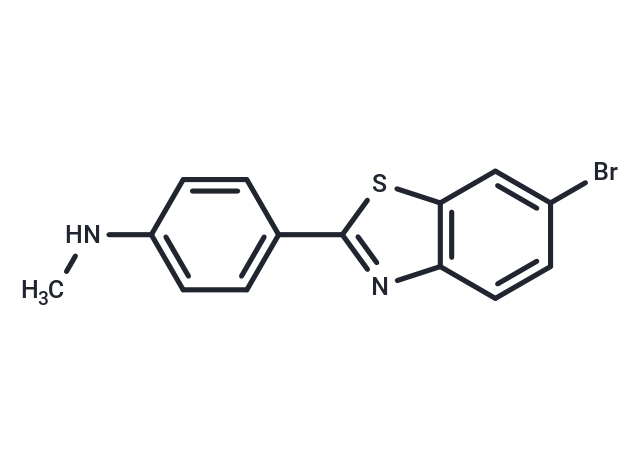购物车
- 全部删除
 您的购物车当前为空
您的购物车当前为空

4-(6-Bromo-2-benzothiazolyl)-N-methylbenzenamine is a potent amyloid imaging agent that binds to Amyloid-β (1-40) (KD: 1.7 nM).

4-(6-Bromo-2-benzothiazolyl)-N-methylbenzenamine is a potent amyloid imaging agent that binds to Amyloid-β (1-40) (KD: 1.7 nM).
| 规格 | 价格 | 库存 | 数量 |
|---|---|---|---|
| 25 mg | ¥ 11,450 | 4-6周 | |
| 50 mg | ¥ 15,500 | 4-6周 | |
| 100 mg | ¥ 19,200 | 4-6周 |
| 产品描述 | 4-(6-Bromo-2-benzothiazolyl)-N-methylbenzenamine is a potent amyloid imaging agent that binds to Amyloid-β (1-40) (KD: 1.7 nM). |
| 靶点活性 | β-Amyloid:ki:1.7 nM |
| 体内活性 | Brain entry in control mice and baboons is high for 4-(6-Bromo-2-benzothiazolyl)-N-methylbenzenamine. Staining of AD frontal cortex tissue sections with 4-(6-Bromo-2-benzothiazolyl)-N-methylbenzenamine indicates the selective binding of the compound to amyloid plaques and cerebrovascular amyloid. The brain radioactivity concentrations (%ID-kg/g) of 4-(6-Bromo-2-benzothiazolyl)-N-methylbenzenamine is remarkably similar in mice and baboons (0.21 vs 0.27). The rate of clearance of radioactivity is considerably slower from the baboon brain than from the mouse brain, although the rank order of clearance rate is similar in mice and baboons. The tissue staining findings utilizing nonradiolabeled, fluorescent 4-(6-Bromo-2-benzothiazolyl)-N-methylbenzenamine are similar to those reported for BTA-1. Both amyloid plaques and cerebrovascular amyloid are stained by 4-(6-Bromo-2-benzothiazolyl)-N-methylbenzenamine in a manner similar to serial sections stained with an antibody to Amyloid-β, and relatively little tissue background staining is observed [1]. |
| 动物实验 | Studies are performed in female Swiss-Webster mice (23-35 g). The mice are injected in a lateral tail vein with 0.37-3.7 MBq (10-100 μCi) of a high specific activity (>7.4 GBq/μmol) 11C-4-(6-Bromo-2-benzothiazolyl)-N-methylbenzenamine contained in <0.10 mL of a solution of 93% isotonic saline and 7% ethanol. The mice are anesthetized and killed by cardiac excision following cardiac puncture to obtain arterial blood samples at 2 or 30 min postinjection. The mouse brains are rapidly excised and divided into the cerebellum and the remaining whole brain (including brain stem) fractions. The brain samples are counted in a gamma well counter, and the counts are decay-corrected to the time of injection relative to 11C standards prepared from the injection solution to determine the percent injected dose (%ID) in the samples. The brain samples are weighed to determine the percent injected dose per gram tissue (%ID/g), and this quantity is multiplied by the whole body weight (in kg) to determine the body-weight normalized radioactivity concentration [(%ID-kg)/g] of each tissue sample [1]. |
| 分子量 | 319.22 |
| 分子式 | C14H11BrN2S |
| CAS No. | 566169-98-0 |
| 密度 | 1.31g/cm3 |
| 存储 | Powder: -20°C for 3 years | In solvent: -80°C for 1 year | Shipping with blue ice. |
评论内容